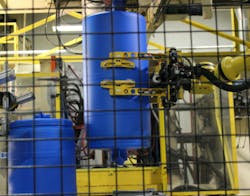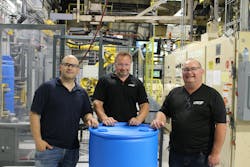Automating the production of industrial plastic drums
Key Highlights
- Custom automation solutions require detailed process analysis to tailor robotic systems to specific blow molding operations.
- Interchangeable tooling and flexible robotic end-effectors significantly reduce changeover times and system complexity.
- Pre-cutting and cooling stations enhance trimming consistency, especially for complex neck flash removal.
- Collaborative design and thorough testing are essential to develop reliable, operator-friendly automation systems.
- Implementing tailored automation can lead to reduced cycle times, increased output and improved product quality.
From the Fall 2025 issue of The Journal of Blow Molding.
By David Mravyan
Minatech Inc.
Over the past several years, blow molding manufacturers have increasingly turned to automation to address persistent challenges of labor shortages, rising operating costs, and the continuous drive for operational efficiency. While the motivation to automate is widely shared across the industry, the implementation is rarely straightforward. No two blow molding operations are exactly alike — differences in part design, equipment layout, product mix and throughput requirements mean that one-size-fits-all solutions are seldom effective.
By examining a recent implementation of a robotic cell in an industrial drum manufacturing environment, this article highlights the key considerations involved in designing and deploying a custom automation system. The case study illustrates how a well-executed solution can unlock significant improvements in efficiency, product quality, consistency and worker safety — all while supporting the flexibility required in modern blow molding operations.
Greif Inc., a global leader in industrial packaging with more than 200 facilities worldwide, has consistently prioritized innovation to remain competitive in a demanding market. As part of its ongoing commitment to operational excellence, the company sought to explore automation opportunities within one of its existing blow molding production lines.
The focus was on producing 55- to 65-gallon tight-head and open-head plastic drums — a product mix that requires adaptable handling and precise post-mold processing. The primary objectives were to interface directly with the blow molding machine, remove the molded drum, deflash the top and bottom flash, and transfer the drum downstream for quality control operations.
For open-head drums, the blow-molded dome at the top of the drum is removed and discarded, eliminating the need for a secondary neck deflashing operation. The solution also needed to support rapid changeovers between product formats and reduce overall cycle time to maximize machine output.
Working closely with Greif’s engineering team, Minatech began the project with a comprehensive information-gathering phase to ensure the automation system would be tailored to the plant’s specific needs. This initial step focused on capturing detailed process data and production constraints. Key considerations included the target cycle time, available floor space in front of the blow molding machine and the mechanical interface required for part takeout — including whether an existing takeout mechanism was in place.
Understanding how mold changes are conducted was critical, particularly whether access is from the front or rear of the machine and if the blow molder is mounted on a rolling base. The team also compiled a complete matrix of drum sizes and shapes that would run on the system to evaluate whether interchangeable or common tooling could be used during format changeovers.
Additionally, the layout had to account for operator access and practical production routines, such as how the system would be safely and reliably restarted at the beginning of each production week.
Blow molding system considerations
When determining the most effective automation approach for part takeout and de-flashing, several key factors must be evaluated to guide the project toward an optimal solution. This begins with a review of the existing takeout method on the blow molding machine and whether the part is susceptible to slipping or sagging during removal.
Material composition plays a critical role in automation design — particularly the percentage of regrind used — as it affects part rigidity and flash characteristics. Additionally, the structural integrity and wall thickness of the blow molded part must be sufficient to withstand both robotic handling and the force of impact trimming. If the part is too flexible or thin, alternative de-flashing methods might need to be considered to ensure consistent results without damaging the product.
Equally important is the location and shape of the flash line. For example, whether the flash is straight, recessed or curved will directly influence trimming strategies and tooling selection. Product geometry — such as whether the drum is round, square or rectangular — affects part orientation, fixture design and access for deflashing. Additional design features, such as a trim band or molded groove, must also be considered, as they can significantly impact the feasibility, repeatability and overall quality of the automated trimming process.
System resilience, consistency and longevity must also be considered during the design of any automated solution. The system should account for typical process wear items and be capable of handling natural variations in product geometry, wall thickness, temperature and flash thickness.
While the ideal scenario assumes that molds are maintained in pristine condition through regular servicing, real-world conditions often differ. For this reason, the automation equipment must be designed with a degree of tolerance to accommodate imperfect mold conditions and continue operating reliably despite minor deviations in part quality or flash formation.
Implementation of automated solutions
It was determined that an industrial six-axis robot would be the most suitable solution for interfacing with the blow molding machine, loading and unloading the de-flash station, and placing the processed drums onto the output conveyor. A six-axis robot offers the flexibility needed to handle the various drum sizes identified in the target product matrix by using programmed recipes to control pick-and-place positions. This approach enables minimal setup and adjustment during product changeovers.
The drum family on this line shared a common cylindrical geometry, with the primary differences being diameter and height. Leveraging this similarity, the end-of-arm tooling (EOAT) was designed to accept interchangeable inserts specific to each drum size, significantly reducing both changeover time and system complexity.
Next, attention turned to the design of the de-flash station. Given that the drum is a thick-walled container with sufficient structural integrity, impact trimming was determined to be a suitable method. The bottom flash line followed a relatively flat, straight path, making it straightforward to trim. However, the flash in the neck area presented a more complex challenge. The neck section of the tight-head drums features two openings and is recessed slightly below the outer circumference of the drum, making it more difficult to access with trimming tools. Compounding this issue, as the mold pinch edges wear over time, the resulting flash becomes thicker and more resistant to removal, requiring additional force and precision from the trimming equipment.
On-site testing was conducted to identify additional technologies that could assist with trimming the neck flash. Through observation of manual trimming techniques performed by various operators across multiple production lines, it became evident that the process significantly benefited from pre-cutting portions of the flash line prior to attempting full removal. This approach reduced resistance and improved trimming consistency.
A range of cutting tools was evaluated and trialed to determine which could be effectively integrated into the robotic system. Pre-cutting strategies were tested at various positions along the flash line, and a range of cutting tools, including standard knives, ceramic blades, heated cutters and ultrasonic knives, was evaluated. To ensure reliable and consistent results, all tests were conducted at different part temperatures after the parts were removed from the blow molding machine.
Results from these trials were directly incorporated into the robotic cell design by mounting a cutting tool onto the robot’s end-of-arm tooling. The robot’s flexibility and range of motion allowed for the execution of various programmed cut paths at controlled approach angles to the trim line. To ensure the drums reached the optimal temperature range for pre-cutting, dedicated cooling stations were designed and implemented. These stations served as staging platforms, allowing the parts to cool and be pre-cut before proceeding to the final neck de-flash operation.
Operational impact of automation on drum production
When implementing a custom automation solution in a blow molding operation, a strong collaborative relationship between the processor (end user) and the automation design team is essential. Success relies on thorough process data collection, a detailed understanding of the production environment and targeted testing of conceptual approaches to accurately simulate the system and de-risk the proposed solution.
Equally important is careful consideration of how operators will interact with the system during daily production. Attention to these factors is critical to achieving a reliable, efficient and operator-friendly automation solution.
By considering part geometry, material behavior, process variability and human interaction, the project delivered a flexible and robust system capable of handling multiple drum formats with minimal changeover time. The speed of the robot, combined with the coordinated operation of supporting stations, also enabled a significant reduction in cycle time — resulting in increased output and improved overall quality and production efficiency.
©2025, SPE Blow Molding Division
About the Author
David Mravyan
David Mravyan is Director of Engineering, Minatech Inc. He completed his Bachelor of Electrical Engineering at Ryerson University in 2006 and earned an MBA from Western University’s Ivey School of Business in 2012. With over 18 years of experience, he has been deeply involved in all aspects of automation system development — from concept creation, design, and engineering to programming, assembly, and on-site commissioning. His experience spans the full lifecycle of custom automation equipment, combining technical expertise with strategic project leadership.

